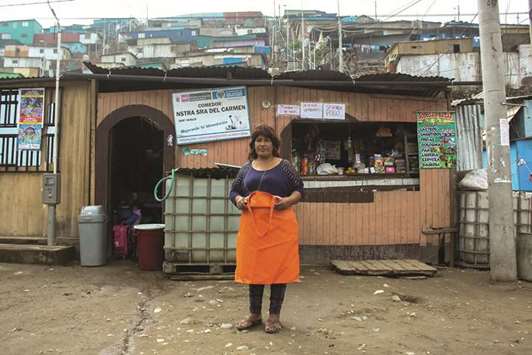There has been much discussion in the Americas about Donald Trump’s proposed wall to separate the US and Mexico. But while that debate rages on, one wall that has already been built continues to provide a stark symbol of the social inequalities in the region.
Winding across a hill in Lima, Peru, this wall is made of concrete and barbed wire. It is 10 kilometres long, three metres high, and separates an exclusive district from the nearby Pamplona slum, populated by urban settlers. Residents call it “the wall of shame.”
“It is the wall of shame because the rich people, on the other side, are ashamed of us, the poor. They see us as something strange, they cover us up because we are an embarrassment,” says Ofelia Moreno, 51, who runs a small eatery in the slum.
The view from the other side is quite different. In a recent documentary film about the wall, a young man from the upscale Casuarinas compound told the cameras: “If that wall did not exist, I think there would be more conflicts because these are two areas in which life is totally different. Integrating these two groups and succeeding in making them live together amicably would be pretty complicated.”
From the top of the hill, those social differences can be seen very clearly. One on side of the wall, the buildings are painted white, there are large houses with swimming pools, dozens of parks and even tennis courts. On the other side, the view is of small, precarious shacks, piles of rubbish, desperately thin dogs and cats, dirt paths and a football field covered in mud.
Construction of the “wall of shame” began in the 1980s when a private school in the Santiago de Surco district, to which Casuarinas belongs, decided it was necessary to protect both students and teachers from the guerrilla war raging in Peru at the time.
Bit by bit, Surco residents continued to extend the wall with permission from the local government, using the argument that they needed to protect their homes from people who were settling on the hill, since they were stealing land.
“Those people come down from the mountains [the Andes] thinking that there are development possibilities in Lima,” says the head the Casuarinas Association, Julio Yturry. “But once they get here they realise that there is nowhere to live because they came with the hope that somebody would give them a place to live for free or on an easy deal.”
By the time the wall was completed in 2014, Moreno and another 300 families had already settled on the other side of the hill, which is part of the San Juan de Miraflores working class district. They constructed small homes using wood and plastic, since they had no money to build on plots of land in urbanised areas.
“Before, [Pamplona] was a rubbish dump where women were raped and criminals took drugs. It was a dark and desolate spot. Now, it is different. It’s pretty and there is a stairway on the hill. Major progress has been made with the help of non-profit organisations and the San Juan de Miraflores municipality,” Moreno adds.
“We never did anything wrong. All we wanted was a bit of land to live on. We look at the wall now and we don’t know what to think. Is it security or is it discrimination?”, says another woman.
Life in Pamplona is tough. There is no running water, so each family has to spend about eight dollars a day to fill a cistern containing about 500 litres of water.
“The water tankers are not even adequately treated to bring us clean water. The drivers say ‘If you want it buy it, if you don’t, don’t.’ They [the company that provides the water] don’t care if our babies get ill,” says another woman.
In addition to the lack of water, Pamplona is also a breeding ground for disease. The lack of a sewage system forces people to dig holes in the highest parts of the hill and use them as makeshift latrines, often completely exposed to the elements. When the latrines are on the verge of overflowing, the residents cover them with waste and dirt.
Peruvian official statistics show that the Latin American country has a population of 31 million. Of those, 6.5 million are poor and 1.2 million live in extreme poverty.
Moreno, who prepares breakfast and lunch for about 125 people every day on a budget of 45 dollars, says that what causes most anger in Pamplona residents is that the wall blocks their way to work in the mornings, forcing them to take a much longer route into Casuarinas.
“There are many people here who work as domestic employees and cooks or in construction on the other side. Before the wall, we could cross over and arrive in an hour. Now we have to go all the way around and it takes up to three hours,” she says.
Children in Pamplona say they miss being able to see the ocean and the lights in downtown Lima from the top of the hill. Sometimes, they lean a ladder against the wall, climb up to the top and peek over to look at the other side and ask themselves: “Why can’t we live over there?” - DPA

Ofelia Moreno, 51, runs a working class eatery where she prepares meals for about 125 people every day.


